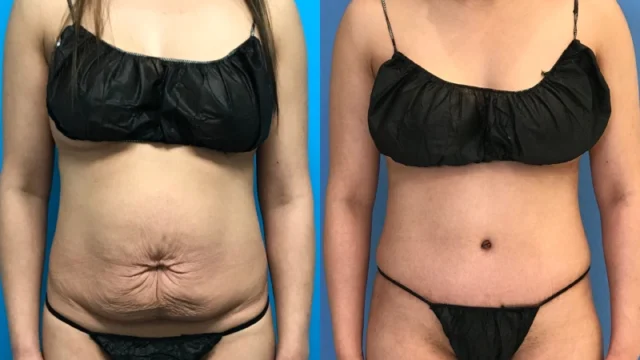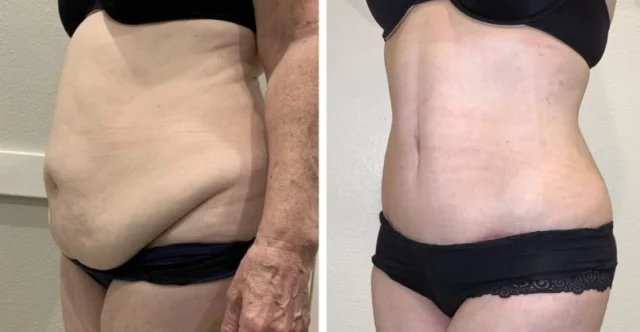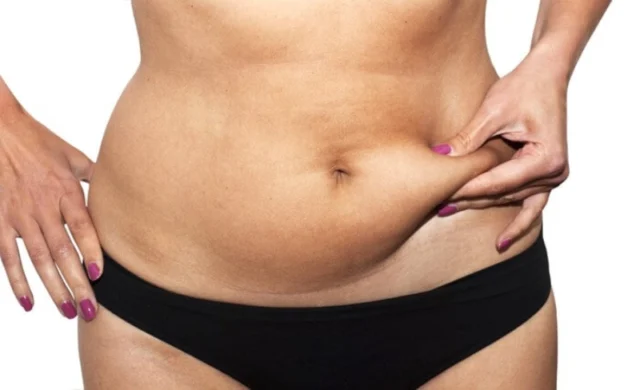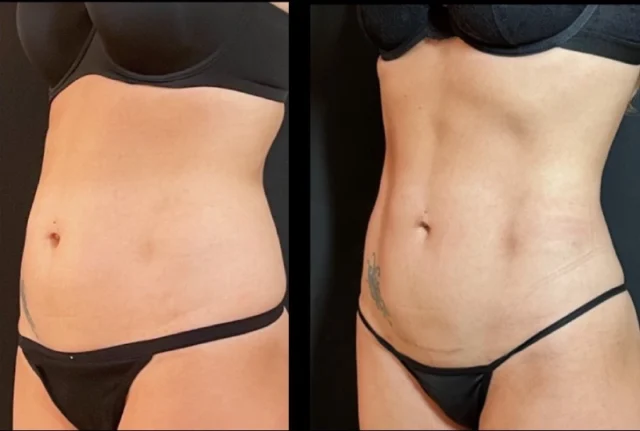Deciding between a tummy tuck and liposuction can feel overwhelming, especially with the flurry of information available. Both procedures aim to transform your body but cater to different needs and goals. A tummy tuck, or abdominoplasty, focuses on removing excess skin and tightening abdominal muscles, making it ideal for those dealing with post-pregnancy changes or significant weight loss. On the other hand, liposuction is a less invasive option designed to target and remove stubborn fat deposits, offering a more refined silhouette without extensive recovery. The choice ultimately depends on your unique body concerns, desired outcomes, and lifestyle. In this article, we’ll break down the key differences, benefits, and considerations of each procedure, helping you make an informed decision on which option aligns perfectly with your transformation goals. Whether you’re looking to regain your pre-baby body or simply streamline your contours, understanding these two popular cosmetic surgeries is the first step towards your new self.
Tummy Tuck vs. Liposuction: Which One Is Right for You?
Understanding Tummy Tuck and Liposuction
When it comes to body contouring, two of the most popular procedures are the tummy tuck and liposuction. A tummy tuck, also known as abdominoplasty, is a surgical procedure that removes excess skin and fat from the abdomen while tightening the underlying muscles. This procedure is particularly beneficial for individuals who have experienced significant weight loss or pregnancy, resulting in loose, sagging skin that cannot be improved through diet and exercise alone. The tummy tuck not only enhances the appearance of the abdomen but also strengthens the abdominal wall, providing a firmer and flatter midsection.
Liposuction, on the other hand, is a minimally invasive procedure designed to remove localized fat deposits that are resistant to diet and exercise. This technique involves the insertion of a thin tube called a cannula through small incisions in the skin. The cannula is used to suction out the fat, resulting in a more sculpted and contoured figure. Unlike a tummy tuck, liposuction does not address excess skin or muscle laxity, making it an ideal option for individuals with good skin elasticity and muscle tone who are looking to refine their body contours.
Both procedures have their unique advantages and are tailored to meet different aesthetic goals. Understanding the fundamental differences between a tummy tuck and liposuction is crucial in determining which procedure is best suited for your needs. By gaining a clear understanding of what each procedure entails, you can make an informed decision and achieve the body transformation you desire.
Key Differences Between Tummy Tuck and Liposuction
One of the primary differences between a tummy tuck and liposuction lies in the nature of the procedures. A tummy tuck is a more extensive surgical operation that addresses not only the removal of excess fat but also the elimination of surplus skin and the tightening of abdominal muscles. This makes it particularly effective for individuals who have loose, sagging skin and weakened abdominal muscles, often as a result of pregnancy or significant weight loss. The comprehensive nature of the tummy tuck allows for dramatic improvements in the contour and firmness of the abdomen.
Liposuction, in contrast, is a less invasive technique that focuses solely on the removal of fat deposits. It does not involve the excision of skin or the tightening of muscles. As a result, liposuction is best suited for individuals with good skin elasticity and muscle tone who are looking to target specific areas of fat accumulation. This procedure can be performed on various parts of the body, including the abdomen, thighs, hips, arms, and neck, offering a high degree of versatility in body contouring.
Another key difference lies in the recovery process. Because a tummy tuck is a more invasive procedure, it typically requires a longer recovery period compared to liposuction. Patients undergoing a tummy tuck can expect a recovery period of several weeks, during which physical activity will be limited to allow for proper healing. Liposuction, on the other hand, usually involves a shorter recovery time, with most patients able to resume normal activities within a few days to a week. Understanding these differences is essential in choosing the right procedure based on your lifestyle and recovery expectations.
Ideal Candidates for Tummy Tuck
Ideal candidates for a tummy tuck are individuals who have excess skin and fat in the abdominal area that has not responded to traditional weight loss methods through diet and exercise. This procedure is particularly beneficial for those who have experienced significant weight fluctuations, leading to loose, sagging skin that cannot be tightened naturally. Women who have undergone multiple pregnancies often find that a tummy tuck helps restore their pre-pregnancy body by addressing stretched skin and separated abdominal muscles.
Additionally, a tummy tuck is suitable for individuals who are in good overall health and have realistic expectations about the outcomes of the surgery. It’s important for candidates to understand that a tummy tuck is not a weight loss procedure but rather a body contouring surgery aimed at improving the appearance of the abdomen. Candidates should be at or near their ideal weight and committed to maintaining a healthy lifestyle post-surgery to ensure long-lasting results.
It’s also important for potential candidates to have a stable weight prior to undergoing a tummy tuck. Significant weight fluctuations after the procedure can compromise the results. Therefore, individuals who are planning to lose a significant amount of weight or become pregnant in the future may be advised to delay the surgery until their weight is stable. Consulting with a qualified plastic surgeon can help determine if you are an ideal candidate for a tummy tuck and what specific modifications may be necessary to achieve your desired outcome.
Ideal Candidates for Liposuction
Liposuction is an excellent option for individuals who have localized pockets of fat that are resistant to diet and exercise. Ideal candidates are those who are at or near their ideal weight but struggle with stubborn fat deposits in specific areas of the body, such as the abdomen, thighs, hips, arms, or neck. Liposuction can effectively target these areas, providing a more sculpted and contoured appearance.
Good candidates for liposuction should have good skin elasticity and muscle tone. This is because liposuction does not address excess skin or muscle laxity, so the skin needs to be able to contract and conform to the new contours of the body after the fat is removed. Individuals with loose or sagging skin may not achieve optimal results with liposuction alone and may require additional procedures, such as a tummy tuck, to address these concerns.
As with any surgical procedure, candidates for liposuction should be in good overall health and have realistic expectations about the outcomes. It’s important to understand that liposuction is not a weight loss solution but rather a body contouring procedure designed to refine and enhance the body’s natural shape. Candidates should be committed to maintaining a healthy lifestyle, including a balanced diet and regular exercise, to sustain the results of the procedure. A thorough consultation with a qualified plastic surgeon can help determine if liposuction is the right choice for your body contouring needs.
Benefits of Tummy Tuck
A tummy tuck offers numerous benefits, particularly for individuals dealing with excess skin and weakened abdominal muscles. One of the most significant advantages is the removal of loose, sagging skin that cannot be addressed through diet and exercise alone. This is especially beneficial for individuals who have experienced significant weight loss or pregnancy, both of which can lead to stretched and sagging skin. By removing this excess skin, a tummy tuck can dramatically improve the appearance of the abdomen, providing a smoother, firmer, and more youthful contour.
In addition to skin removal, a tummy tuck also tightens the underlying abdominal muscles. Pregnancy and significant weight fluctuations can cause the abdominal muscles to separate and weaken, leading to a protruding or sagging belly. A tummy tuck repairs and tightens these muscles, resulting in a flatter and more toned abdomen. This not only enhances the overall appearance but also improves core strength and stability, which can have positive effects on posture and physical performance.
Another benefit of a tummy tuck is the potential improvement in the appearance of stretch marks. While the procedure is not specifically designed to remove stretch marks, it can significantly reduce their appearance, particularly those located on the lower abdomen. By excising the skin that contains stretch marks, the remaining skin appears smoother and more even. Overall, a tummy tuck offers comprehensive benefits for individuals seeking to improve the contour, firmness, and appearance of their abdomen, making it a highly effective option for body transformation.
Benefits of Liposuction
Liposuction provides a range of benefits for individuals looking to target and remove stubborn fat deposits that are resistant to traditional weight loss methods. One of the primary advantages of liposuction is its ability to precisely sculpt and contour the body. By targeting specific areas of fat accumulation, liposuction can create a more balanced and proportionate figure, enhancing the overall aesthetic appearance. This procedure is highly versatile and can be performed on various parts of the body, including the abdomen, thighs, hips, arms, and neck, allowing for customized body contouring.
Another significant benefit of liposuction is its minimally invasive nature. Compared to more extensive surgical procedures like a tummy tuck, liposuction involves smaller incisions and less tissue disruption. This results in a shorter recovery time and reduced risk of complications. Most patients can return to their normal activities within a few days to a week, making liposuction a convenient option for those with busy lifestyles. The less invasive approach also means less scarring, contributing to a more aesthetically pleasing outcome.
Liposuction also offers long-lasting results, provided that patients maintain a healthy lifestyle post-procedure. The fat cells removed during liposuction are permanently eliminated, meaning they cannot return. However, it is important to note that remaining fat cells can still enlarge if significant weight gain occurs, so maintaining a stable weight through a balanced diet and regular exercise is essential. Overall, liposuction provides an effective and efficient solution for those looking to refine their body contours and achieve a more sculpted and toned appearance.
Risks and Considerations for Each Procedure
As with any surgical procedure, both tummy tuck and liposuction come with their own set of risks and considerations. Understanding these potential risks is crucial for making an informed decision and preparing for the procedure. For a tummy tuck, the primary risks include infection, bleeding, and complications related to anesthesia. Additionally, there is a risk of poor wound healing, which can lead to noticeable scarring. It’s important to follow post-operative care instructions carefully to minimize these risks and promote proper healing.
Another consideration for a tummy tuck is the recovery process. Due to the more invasive nature of the procedure, patients can expect a longer recovery period, typically several weeks. During this time, physical activity will be limited to allow for proper healing. Patients may also experience discomfort, swelling, and bruising, which can be managed with prescribed medications. It’s important to have realistic expectations about the recovery process and to plan accordingly, including arranging for time off work and assistance with daily activities.
For liposuction, the risks are generally lower due to the less invasive nature of the procedure. However, potential risks still exist, including infection, bleeding, and contour irregularities. In some cases, patients may experience changes in skin sensation, such as numbness or tingling, which usually resolve over time. It’s also important to note that liposuction does not address excess skin or muscle laxity, so individuals with significant skin sagging may not achieve optimal results with liposuction alone. Consulting with a qualified plastic surgeon can help identify potential risks and determine the best approach for achieving your desired outcome.
Recovery Process: Tummy Tuck vs. Liposuction
The recovery process for a tummy tuck and liposuction can vary significantly due to the differences in the nature and extent of the procedures. For a tummy tuck, the recovery period is generally longer and more involved. Immediately after the surgery, patients will need to wear a compression garment to support the abdomen and minimize swelling. It’s common to experience discomfort, swelling, and bruising in the first few days, which can be managed with prescribed pain medications. Patients are typically advised to take at least two weeks off work and avoid any strenuous activities for several weeks to allow for proper healing.
During the initial recovery period, it’s important to follow all post-operative care instructions provided by the surgeon. This may include caring for the surgical incisions, avoiding heavy lifting, and gradually increasing physical activity as recommended. Full recovery from a tummy tuck can take several months, during which time the final results of the procedure will gradually become more apparent. Patience and adherence to post-operative guidelines are key to achieving the best possible outcome.
In contrast, the recovery process for liposuction is generally shorter and less restrictive. Most patients can return to their normal activities within a few days to a week, depending on the extent of the procedure and the areas treated. Similar to a tummy tuck, patients will need to wear a compression garment to reduce swelling and support the treated areas. Discomfort, swelling, and bruising are common in the initial days following the procedure but typically resolve more quickly than with a tummy tuck. It’s important to follow the surgeon’s post-operative care instructions and attend follow-up appointments to ensure proper healing and optimal results.
Cost Comparison: Tummy Tuck and Liposuction
Understanding the cost of each procedure is an important factor in making a decision between a tummy tuck and liposuction. The cost of a tummy tuck can vary widely depending on several factors, including the surgeon’s experience, the geographic location of the practice, and the complexity of the procedure. On average, a tummy tuck can range from $6,000 to $12,000. This cost typically includes the surgeon’s fee, anesthesia fees, operating room fees, and post-operative care. It’s important to note that additional costs, such as pre-operative medical tests and compression garments, may also be incurred.
Liposuction, on the other hand, is generally less expensive than a tummy tuck due to the less invasive nature of the procedure. The cost of liposuction can also vary based on the same factors, with the average cost ranging from $2,000 to $7,000 per treatment area. Since liposuction can be performed on multiple areas of the body, the total cost can increase based on the number of areas treated. Similar to a tummy tuck, the cost of liposuction typically includes the surgeon’s fee, anesthesia fees, and operating room fees.
When considering the cost of either procedure, it’s important to keep in mind that the cheapest option may not always be the best. Choosing a qualified and experienced plastic surgeon is crucial for achieving safe and satisfactory results. Additionally, some practices may offer financing options to help make the procedures more affordable. Consulting with a plastic surgeon can provide a detailed cost estimate based on your specific needs and goals, allowing you to make an informed decision that aligns with your budget.
Making the Right Choice: Consultation with a Surgeon
Ultimately, the decision between a tummy tuck and liposuction should be made in consultation with a qualified plastic surgeon. During the consultation, the surgeon will evaluate your medical history, current physical condition, and aesthetic goals to determine the most appropriate procedure for your needs. This is an opportunity to discuss any concerns or questions you may have about the procedures, including the risks, benefits, recovery process, and expected outcomes.
The surgeon will also perform a physical examination to assess factors such as skin elasticity, muscle tone, and the distribution of fat deposits. Based on this assessment, the surgeon can recommend the best course of action to achieve your desired results. In some cases, a combination of procedures, such as liposuction followed by a tummy tuck, may be suggested to address multiple concerns and enhance the overall outcome.
It’s important to choose a board-certified plastic surgeon with extensive experience in body contouring procedures. Reviewing before and after photos of previous patients can provide insight into the surgeon’s skill and the potential results you can expect. Open and honest communication with the surgeon is key to ensuring that you have a clear understanding of the procedures and that your goals and expectations are aligned. By taking the time to thoroughly research and consult with a qualified professional, you can make an informed decision and take the first step towards achieving your body transformation goals.






